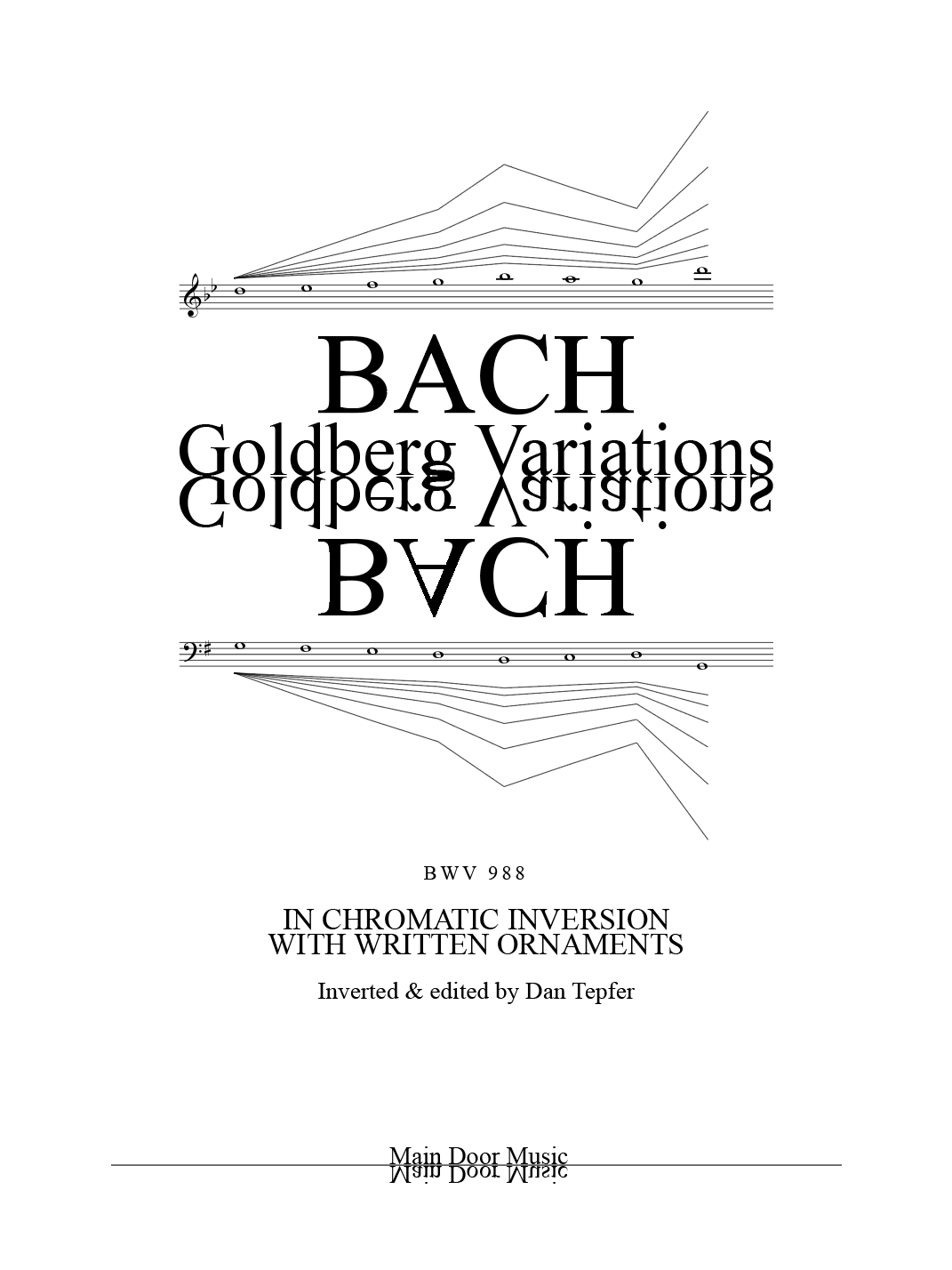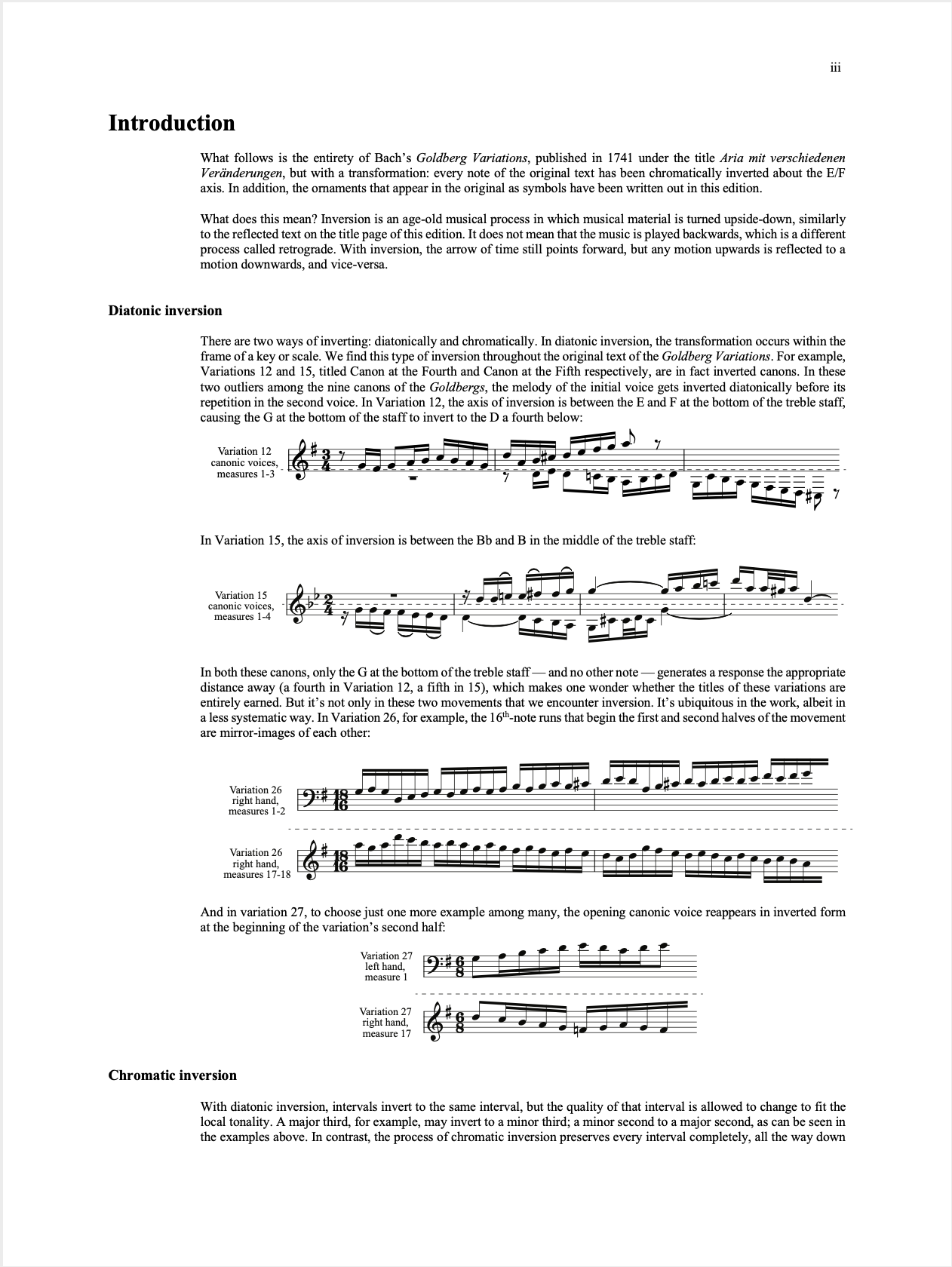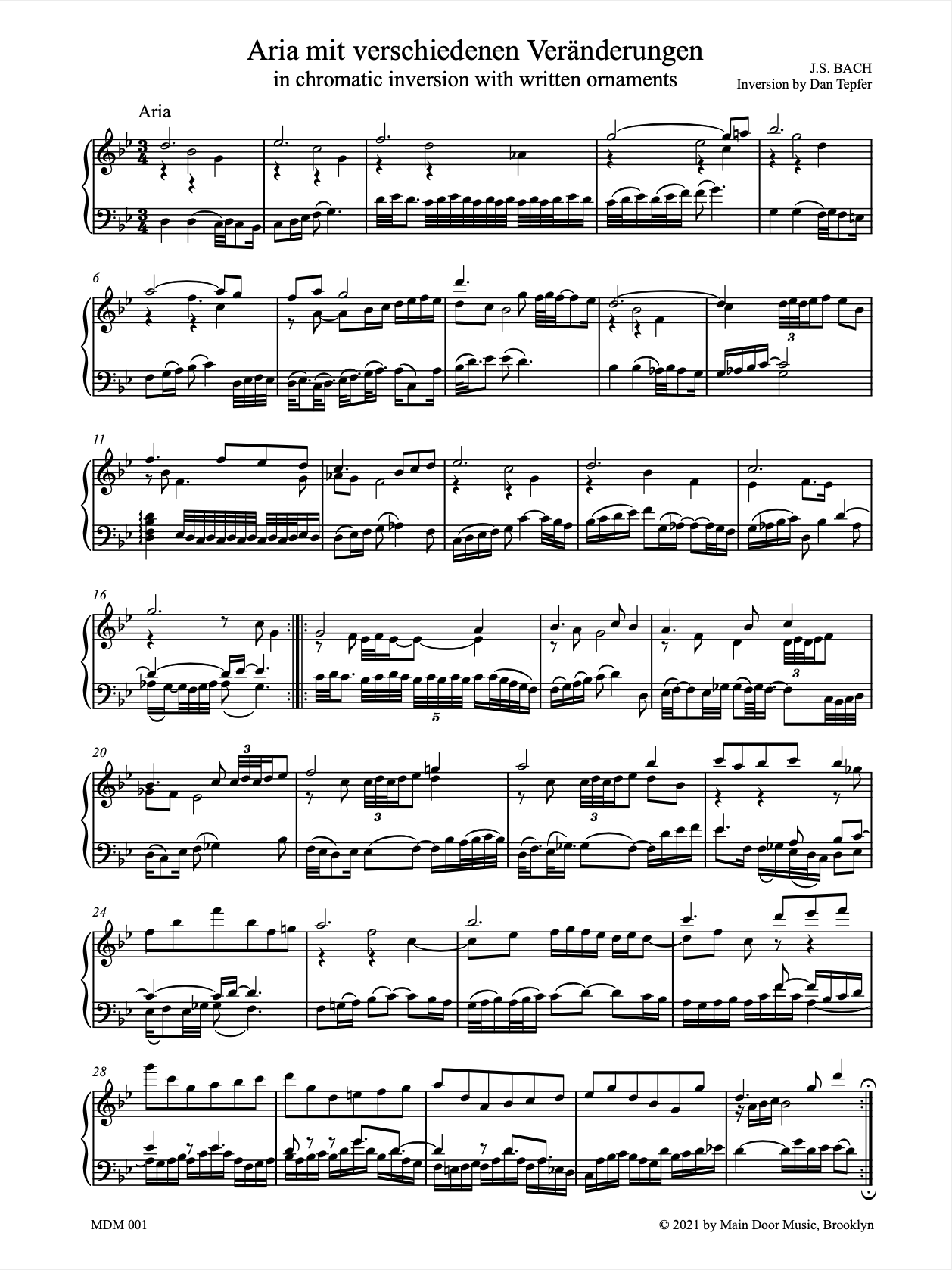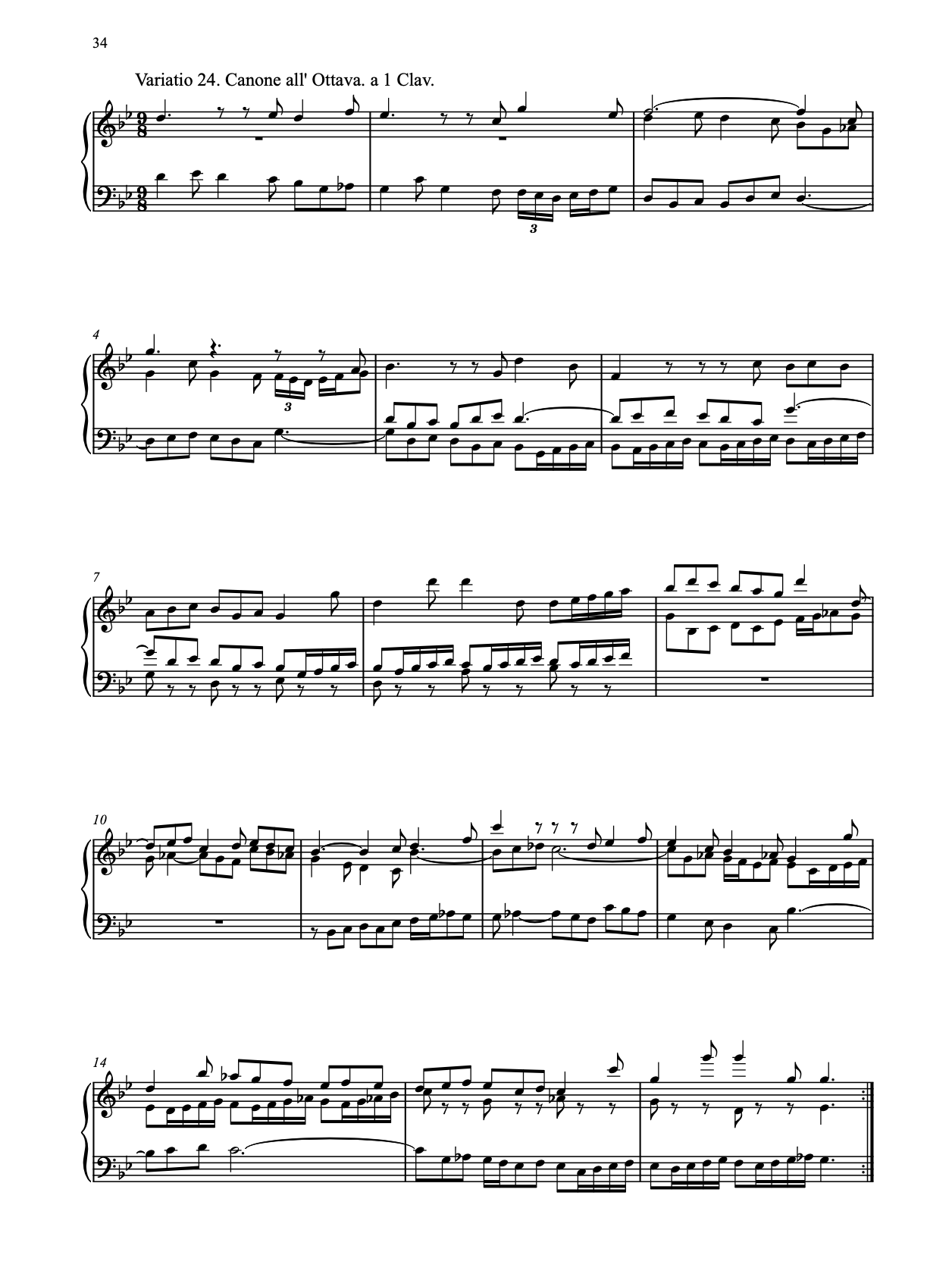

As of December 2021, physical scores of the #BachUpsideDown Goldberg Variations are available for purchase for $35. They're printed and bound by a company that specializes in musical scores, with an introduction explaining the inversion process and its effects on the work. 58 pages.
Contact me for shipping outside of North America and Europe




What to do during a pandemic? On March 18th, 2020, with the COVID-19 coronavirus rapidly expanding in New York City, with all my gigs canceled for the foreseeable future, confined to my home, I decided to make a complete #BachUpsideDown video recording of the Goldberg Variations. This felt like an achievable goal that just might keep me sane.
Bach was such a badass, and — to be more specific — such a master of counterpoint, that his music sounds almost as good upside down as it does right side up. So I wrote a computer program that records what I play, then plays it back upside down. The amazing thing about this approach is that the music feels brand new, like a new piece, very different from the original. It's like looking at Bach through a prism, and it makes me fall in love with his music all over again.
What do I mean by upside down? I mean inverted, and specifically chromatically inverted. Since the Goldbergs are in G Major, I'm inverting about the axis between E and F. This isn't the place to explain the details of how and why this works, but what it does is make the inverted version end up in G minor. So the Goldbergs stay in G, but move from Major to Minor — and vice versa for the minor variations.
Counterpoint is all about interval relationships. Really, it's the study of which intervals sound good, which are problematic, and how to move between them. The key thing about inversion — chromatic inversion as opposed to diatonic inversion — is that it preserves interval relationships exactly: a major third always inverts to a major third, a minor sixth to a minor sixth, and so on. So the key elements that make counterpoint work — the intervals between notes — are the same in the inversion as they are in the original. The only difference is the direction in which the notes move, and the order of the notes, i.e. which is on the bottom and which is on the top. This does raise some questions. For example, in traditional counterpoint, a suspension (a tone from a previous chord that is carried into the next as a dissonance) always resolves downwards. This is a fundamental aspect of counterpoint, akin to gravitation. In these inverted pieces, these same suspensions resolve upwards. This in itself gives a very different, eerie feeling to the proceedings.
Thanks to Steve Coleman for inspiring my first explorations of chromatic inversion in jazz through his negative harmony concept.
My hope is pianists will learn some of these upside-down Goldbergs and post recordings / videos of them under the #BachUpsideDown hashtag. Please drop me a line if you do!
Posted 3/17/20
The Aria sets out the framework for the 30 variations that follow. In particular, each variation follows the same harmonic structure as the Aria; but there are other connections as well. The Aria has 32 bars, and there are 32 movements (including the opening and closing Arias) in the work. The Aria is divided into two 16-measure parts, with a clear demarcation in the middle, where the repeat bars are. Likewise, the Goldbergs have a clear division at the mid-point, between Variations 15 and 16, evidenced by Bach's choice to make Variation 16 an "Overture" — a French Overture, to be precise.
I've chosen to write out the ornamentation in this score, because when inverting ornamentation, it functions differently than we are used to, and I'd have to invent a new notation to indicate what kind of ornaments should be used. This seems more practical.
Posted 3/18/20
One of the most joyful and fun of the variations, this one sounds particularly good in inverted form. I mean, they all work surprisingly well, but this one stands out.
Posted 3/19/20
This variation's identity lives in its constant pulsing bass line. Interesting to see what happens with that when it becomes a high melodic part, in the inverted version.
Posted 3/20/20
Variation 3 is the first canon in the set, and it's probably the densest, because it's a canon at the unison. The two voices constantly intertwine and overlap. In the original version, the left hand part serves as an accompaniment to the two canonic voices in the right hand; but in the upside down version, it feels like the lead melody. Because Bach has to jump through so many hoops here — the requirements of the harmonic structure, the rules of counterpoint, the necessity of making meaningful melodies, and the strict rules of a canon at the unison — he takes some liberties with the harmonic structure; these sound particularly surprising in the inversion.
Posted 3/21/20
This one's an outlier in the Goldberg Variations. No other variation has this kind of jagged intervallic movement. The inversion is amazing! I'd never heard the inverted form of this Var until tonight and I'm blown away — the wide intervallic jumps of the original make the inversion incredibly surprising, and the dance rhythm holds it all together.
Posted 3/22/20
A true high-wire act. Hearing this variation as a teenager is what made me want to learn the Goldbergs. Five variations in, Bach hits you with this stunning combination of virtuosity, keyboard gymnastics, and drama, and if you're new to the Goldbergs, you know at this point that you're in for something special. The inverted version is a revelation! Hearing it made me notice, for the first time, that the beginning of the second half of the variation is an inversion of the first half. It also made me hear some internal voices that had escaped me until now.
Posted 3/23/20
This is the second canon in the set, a canon at the rising second. In the right hand, everything that gets played in the first voice gets repeated a bar later in the second voice a step above. This one makes me think of falling rain, and has extraordinary harmony, which gets all the more extraordinary and weird — in the best way — in the inversion.
Posted 3/24/20
A dance variation, and one of the few to feature a tempo indication, "al tempo di Giga". I often imagine people dancing when I play it. The two-voice texture, and the fact that the left hand is nearly as melodically engaging as the right makes it work particularly well in inverted form.
Posted 3/25/20
This was never meant to be played on piano. The Goldbergs were written for harpsichord with two manuals (i.e. keyboards), one above the other, and this variation makes it obvious how helpful that would be. On piano with only one keyboard, it's a battle to keep your hands from getting tangled up in each other. Of course, the Disklavier doesn't have this problem when it's playing the inversion...
Posted 3/27/20
The third canon in the set, a canon at the descending third — meaning that whatever is played in the first voice in the right hand is repeated a bar later a third down in the second voice. This one is particularly stunning in the inversion.
Posted 3/29/20
In this one, subtitled "Fugetta", Bach is playing with the idea of fugue — where a theme enters repeatedly in different voices and keys — without writing an actual fugue. The way the fugal theme enters in each of the four voices here makes for a very compelling inversion.
Posted 3/30/20
One of the most joyful of the variations, with an infectious 12/16 groove, this one's a total tongue-twister to play on piano.
Posted 4/2/20
There's a lot to say about this one, because it's the first of two inverted canons in the set. What this means is that whatever gets played in the first canonic voice gets repeated a bar later in the second canon voice *inverted*, i.e. upside down. Sound familiar? Yes! This is exactly what I'm doing in the BachUpsideDown project in the first place. So: Bach is applying the inversion process to his canon, the two voices mirroring each other around his chosen axis of symmetry, and then my program inverts the whole thing again. In my inversion, the canonic melodies end up virtually the same as the original ones, only displaced in time, because an inversion of an inversion... is the original. There's one subtle catch, though: Bach is practicing diatonic inversion, whereas mine is chromatic. So, when he inverts diatonically, and then I invert back chromatically, the end result is a subtly skewed version of the original. The next variation that's an inverted canon is variation 15, which in addition will be the first *minor* variation of the set — which will invert to major. Lots to look forward to.
Posted 4/4/20
This is perhaps my favorite so far. The original variation, the first contemplative and introspective one in the set, is incredibly lovely. It's one of the most straightforwardly sincere of the bunch, with a mix of innocence and sadness that gets me every time. The inversion works shockingly well, with the melody in the bass and the two supporting voices in the treble — a more ominous version of the original, but still just as poignant in my opinion.
Posted 4/5/20
An incredibly spectacular variation and a stunning follow-up to the deeply introspective one that comes before, Variation 14 is also special because its second half is essentially an inversion of the first half. So, in my inversion, the first half ends up sounding like the second half of the original, and vice versa! For this reason, of all the variations so far, this is one of the best-sounding in upside-down form.
Posted 4/12/20
One of the most austere of the variations, this is also the second of only two inverted canons in the set, meaning the second canonic voice repeats the first in diatonic inversion. But what really distinguishes this variation is that it's the first in the set to be in the minor mode. All others so far have been in G Major; this one is in G minor, with Bach transposing the chord progression of the Aria to the parallel minor. So guess what? My chromatic inversion process turns this back into G Major! But, because of the dense chromaticism inherent in Bach's treatment of minor, this is a very strange and new kind of Major, a Major with chromatic motion I've never heard before. On top of this, this is the only variation so far to end with a completely satisfying final cadence in its inverted form. And this happens precisely at the end of the variation that concludes the first half of the Goldbergs! Could this be a coincidence? It could — but I'm very tempted to say it's not.
Posted 11/19/20
I recorded the first 15 variations of the Goldbergs in March and April, right as the coronavirus pandemic began. Now, six months later, it's time to continue. Variation 16 is an outlier. It's a French Overture, the only variation of this style in the bunch, and it opens the second half of Bach's Variations with a bang. It's so clearly a new beginning in the work that it's probably the strongest argument for the idea that the variations are structured in two halves of 15 variations each. Also, it's the only variation with a change of meter. The first half is in a stately 2/2, and then we have a sudden shift to an energized 3/8 in the second half. This, to me, also says something about the division of the work in two: the first half is in the past, a memory, and we now dive headlong into the second half.
Posted 11/20/20
I love this variation, and it’s also one of the hardest to play properly on the piano, because your hands get constantly tangled up in each other (it was written for two-manual harpsichord). I imagine this variation as two swallows chasing each other through the air, imitating each other’s moves, moving in close, veering apart, darting around in ecstatic freedom. This feeling of visceral joy is perhaps even stronger in the inversion.
Posted 11/20/20
Variation 18 is a canon at the rising 6th, and it may be the sweetest of all the canons in the set. Much of the melodic action takes place in the left hand while the canonic voices in the right hand take a back seat — so in the inversion, the melody finds itself back on top.
Posted 11/21/20
Bach uses only three ideas here, but he keeps shifting them between the three voices so skillfully that it feels like much more than that. It works amazingly well in the inversion — I think I might like it even more than the original.
Posted 11/23/20
This one's so wild, it’s hard to believe it was written in 1741. Full of dense chromaticism while pushing the technical possibilities of the keyboard with acrobatic hand-crossings, Variation 20 is where the Goldbergs start to absolutely blow the listener's mind. There's so much symmetry in the original, with the process of inversion already so present, that the upside-down version sounds remarkably similar — but in a different harmonic world. I particularly love how the opening shows up in the visualizer: as the two voices cross and uncross repeatedly, they make a star.
Posted 11/23/20
A canon at the rising seventh, many people call this one their favorite. Bach repeats the leading voice two beats later a seventh above — a remarkably dissonant interval that he makes work with utmost naturallness and beauty. 21 variations into the set, it’s only the second variation in the minor mode, and it has a searching, introspective quality that only gets intensified in the inversion, even though the inversion is technically in the major mode! But it’s a very chromatic and mysterious major mode, because the minor mode is treated very differently from the major; so, if you invert minor, you don’t get normal major. You get something else.
Posted 11/24/20
One of the most jovial of all the variations, this one's based on a simple motive that gets constantly repeated throughout. The simplicity of the original makes the inversion really distinguish itself, in particular with regard to the harmony, which you can hear at its most fundamental here in its inverted form.
Posted 11/28/20
Bach is obsessed with the musical interval of the third here. First, it shows up in an extremely tight canon where the second voice enters only an eighth note behind the first; then in a trilled melody that moves up in thirds eight consecutive times as the second voice interjects in wild blurts; then in an unusual number of consecutive thirds and sixths (an inverted third) between two contrapuntal voices; and finally, after these first three ideas have been developed, it shows up in the last section, where both hands play thirds and sixths in a hilarious hocket. This one is so wild it shocks me every time I play it.
Posted 12/1/20
This is the eighth canon in the set, so it's a canon at the octave: everything played in the leading voice gets repeated two bars later an octave away. But is it an octave above, or an octave below? This is, in fact, the first variation where Bach explicitly switches the direction of the canon while the variation unfolds. In the first quarter of the variation, it's an octave above, in the two next quarters it's below, and in the final quarter it's above again — a ↑ ↓ ↓ ↑ construction that must have appealed to Bach for its symmetry. I write about this change of canonic direction at further length here.
Posted 12/5/20
Wanda Landowska called this one the “black pearl” of the Goldberg Variations, and the image fits. Variation 25 sits at the emotional core of the set, a deeply introspective and brooding reimagining of the Aria that is also a huge harmonic flex from Bach. He transforms the simple harmonies that dominate the Goldbergs into a labyrinth of dense dissonances that resolve in the most glorious yet unexpected ways. Nothing is gratuitous here: all this incredible harmonic color fits squarely into the existing meta-structure in the form of chromatic passing chords — or what we’d call a “reharm” in jazz-speak. One aspect of this variation that’s hardly ever mentioned is the rhythm. Bach is constantly pushing against the 3/4 meter here, often delaying or anticipating the downbeat in a way that requires concentration for it to be heard properly. Without variation 25, the Goldbergs simply wouldn’t be the Goldbergs. And wait until you hear the inversion; I find it utterly mind-blowing. We’ve heard the original so much that it’s easy to grow complacent towards the extremity of the dissonances that Bach creates. Not so in the inversion, which makes you hear these chromaticisms anew and sounds as modern as it comes.
Posted 2/13/21
Variation 26 is a barn-burner, a shocking contrast to the deep introspection of Variation 25. It needs to be fast to make this contrast as stark as possible, and the extreme hand-crossing combined with the symmetry of the left and right hands makes this perhaps the most technically challenging of all. Did I mention that this variation is in two time-signatures simultaneously? The lines are in 18/16, the chords in 3/4. One of my favorite aspects of this variation is the harmony, with the chords constantly suspending against the prevailing harmony of the lines. In the inversion, these suspensions sound wild, like nothing I've heard before.
Posted 2/17/21
Variation 27 is an outlier. It's the ninth and last canon of the set, but it's the only one that doesn't have a third voice freely accompanying the two canonic voices. So, in this variation, Bach has the extraordinary challenge of having to fully express the harmonic structure of the Aria with only two voices, constrained to the hilt: the second voice must repeat the first a diatonic ninth away, a bar later. In many ways, it isn't even two voices, but just one, with a displaced echo of itself. Also, the direction of the canon changes in this variation: in the first half, the answer occurs a ninth above, in the second half a ninth below. That Bach manages to navigate these tight constraints so elegantly, with every melody making sense and all the counterpoint working so well, is amazing. But you wouldn't notice it, because he makes it sound so easy.
Posted 2/18/21
We're in the final stretch now. The build at the end of the Goldberg Variations is one of the most satisfying aspects of the work. It starts at Variation 26, which presents an ecstatic contrast to Variation 25's dark night of the soul, and reaches its climax with Variations 28 and 29, which both employ musical devices designed to be spectacular. The chief element that Bach plays with here is the trill. He takes it to extremes, and seems to delight in its ambiguity: a trill has two notes, one part of the underlying harmony, and the other usually not, but who's to say which is which? They can be used to introduce foreign tones into a chord without violating the rules of counterpoint, a kind of have-your-cake-and-eat-it-too that Bach uses to the hilt here. I particularly love how this variation sounds upside-down. It's so surprising, and part of the reason is that in trills, we're accustomed to the non-chordal note being on top. But here, with the trills inverted along with the rest, the non-chordal note is on the bottom, which only heightens the overall ambiguity.
Posted 6/17/21
Variation 29 is the sister to Variation 28 — they’re inseparable, working together to provide the climax of the entire set. If no. 28 is when we reach the top of the mountain, in no. 29 we’re teetering on the edge of the cliff that precedes our inevitable descent. It’s the very end of the build, and it’s tantalizing. The drama is perfectly preserved in the inversion, and the way the harmonies are transformed is particularly exciting to me here.
Posted 2/10/25
We've come to the end of this journey, and Bach doesn't let us down. Where we would expect a Canon at the Tenth, three variations after the Canon at the Ninth of Variation 27, he gives us something completely different: a Quodlibet, a mashup of popular tunes of the day. At the end of this vast journey, as the closing Aria beckons, Bach chose songs that have to do with goodbyes and rekindling. "I have so long been away from you, come closer, come closer", says one. "Cabbage and turnips have driven me away, had my mother cooked meat, I'd have opted to stay", says another, bringing a work that is often reaching towards the divine an ending that belongs in the realm of regular human beings.